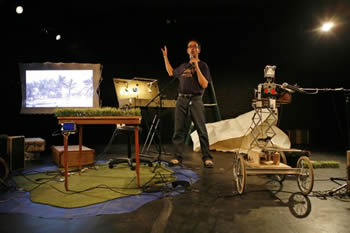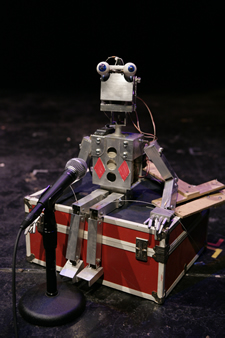
Modern Geek Theater
By Paul David Young
The Jester of Tonga
By Joseph Silovsky
P.S. 122
(closed)
If there is subgenre called "geek theater"
it's what Joe Silovsky is doing in his one-man, one-robot show
The Jester of Tonga, which recently concluded a short
run at P.S. 122. And I mean this in a kindly way.
In Silovsky's stage presence, the technology
of the production, and content, The Jester of Tonga is
thoroughly and charmingly geeky. It reminds me a lot of the sweet
inventions that my grandfather was always coming up with to entertain
us children: constantly changing dioramas hidden behind an oil
painting, a haunted house built into his attic, an elaborate miniature
circus for which he had carved all the animals.
The difficulty with Silovsky's particular
application of the geek aesthetic is that it ends up being an
arid and forgettable enterprise. He steadfastly refuses to own
up to a personal connection to the material, other than the rather
neutral fact, which he finally mentions halfway through the show,
that on his birthday in 2001 he happened to find an article in
The New York Times describing how the king of Tonga had
lost millions of dollars on exotic investments in the United States.
Would it be too much to ask why Silovsky was intrigued by this
material? The connection must have been strong for him to have
pursued the project for seven years, but he never tells us anything
about this.
I understand and am sympathetic to Silovsky's
strategy of eliciting myriad narrative strains from his apparently
random find. He does create an interesting, though confusing space
in which to think during his show. During the first half, unless
we read the press release, we don't know why he's telling us any
of these stories or doing a flyby review of the mathematics of
viatical valuations. In the second half, after he belatedly discloses
the Tongan news article, we can begin to construct a mental diagram
of the crisscrossing paths. Some of these relate to Silovsky's
pursuit of stories and people at considerable remove from the
Tongan financial disaster. Others are byproducts of his performance
archeology, people and random facts that turned up over the years
of his research. He could, however, have created a vastly more
interesting and layered experience had he been more careful about
his digging -- preserving the images of the objects uncovered,
illuminating their provenance, and probing further at every turn.
I'm not asking for easy answers, or even any answers, but rather
greater respect for his delightful discoveries and for the geeks
in his audience who want to know more about him and the Jester.
That's why we came to the theater in the first place.
Silovsky's self-defeating caution finds
its metaphor when he hides behind a screen for the opening sequence.
Attached to the screen is a hand-painted sign with the title "Jester
of Tonga." Silovsky settles in at a microphone and tells us it's
going to be a long journey, by which he's referring to many things:
the travel time between New York and Tonga, the seven-year duration
of the project, and the layers of information and story that will
occupy the evening. Oddly, despite his reported obsession, Silovsky
seems ambivalent about the task of performing; he holds back,
neither showing enough of his amiably awkward self nor plunging
full-on into his material.
As he narrates the opening sequence in
his mellifluous voice, he operates deliberately crude miniatures
in a contraption that works as a kind of projecting light box.
During the first journey, a model plane on a visible wire flies
in front of painted clouds. Silovsky is not interested in stage
illusionism, except to provide a good laugh. The stage is stripped
to the walls and loaded with things, each of which will play some
role in what is to come. The undisguised operation of these contraptions
is the great geeky pleasure of his show.
He's soon telling us one of many stories
about outsiders venturing into the Pacific. In this first one,
a cut-out boat runs aground on a Pacific atoll. Paper lightning
bolts dart in from the "sky," visibly manipulated by Silovsky.
He produces oral sound effects as well as the voice-over narration.
In this ghastly story, shipwrecked voyagers consider eating a
dead crew member, since they've little other food. When they valiantly
choose to send him off to a sea burial instead, the deceased is
represented by a series of smaller and smaller effigies that appear
in succession as his body floats away.
Silovsky then happily tells us that this
story is irrelevant to the main subject of the evening. During
the short set-up break that follows, we see him scurrying around
the stage, dressed in full geekwear: a "Larry's Steakhouse" t-shirt
and jeans and clever eyeglasses. In what seems at the time to
be another irrelevance, he gives a short lecture on viaticals,
a commercial exchange in which the owner of a life insurance policy
sells the benefits to someone else, in effect placing a bet on
when he will die. The seller is typically someone who has been
diagnosed with a fatal disease and wants to cash out on the policy.
An Arizona company called Millennium Art Management packaged viaticals
into securities that it marketed as a mutual fund, Silovsky explains.
Silovsky is endearingly awkward here, seeming to apologize for
the fact that he actually understands the mathematics of how viaticals
are valued and securitized.
But we hardly have time to puzzle over
the purpose of this lecture before he launches into his next sequence,
about the arrival of the man who will become the Jester of Tonga.
The arrival is staged inside a suitcase, which opens to reveal
a pop-up diorama of the main island of Tonga, a South Pacific
archipelago. Cameras inside the case provide live video feed to
monitors distributed throughout the theater. A cut-out boat dances
up to the island. Small figures of islanders wait by the shore.
Silovsky pushes a button and the king's palace pops up. He describes
the special gifts the visitor brings to please the king's peculiar
tastes: a clock (the king is obsessed with time) and a statue
of a cowboy (replica of a much larger one that is visible from
an interstate highway in the American West, we're told in another
digression). Some background information on Tonga is offered,
using a large sheet of paper to show what a small island it is
in the middle of the vast Pacific.
Only at this point does Silovsky finally
provide a clue to his fascination with Tonga, belatedly mentioning
the Times article which reported that, under the guidance
of someone variously known as Dean Jesse or the Jester of Tonga,
the Tongan government lost several million dollars by investing
in viaticals.
 To
play the part of the Jester, Silovsky introduces Stanley, a robot
of his own creation, with limited mobility and functionality.
The Jester's recorded voice speaks through Stanley, who moves
his arms and head in a rudimentary facsimile of human behavior,
while Silovsky performs live beside him. This technique of pairing
a live performer with a recorded presence is a staple of The Builders
Association, a group for which Silovsky works. Because of Stanley's
technological limitations, however, he shares many of the same
problems as Silovsky on stage. Like Silovsky, Stanley is only
haltingly present.
To
play the part of the Jester, Silovsky introduces Stanley, a robot
of his own creation, with limited mobility and functionality.
The Jester's recorded voice speaks through Stanley, who moves
his arms and head in a rudimentary facsimile of human behavior,
while Silovsky performs live beside him. This technique of pairing
a live performer with a recorded presence is a staple of The Builders
Association, a group for which Silovsky works. Because of Stanley's
technological limitations, however, he shares many of the same
problems as Silovsky on stage. Like Silovsky, Stanley is only
haltingly present.
The Jester's life story is an absurd vortex
of alternative California lifestyles from the 1960s onward. Jesse
gets stoned for ten years straight until he discovers Kundalini
yoga, which unleashes in him the capacity to read minds and costs
him two sleepless weeks. The insomnia ends when he happens upon
a roomful of chanting Buddhists, which somehow leads him to a
job in a local bank despite the fact that he knows nothing about
financial services. At the bank he chances upon the Tongan account.
Jesse becomes the Tongan king's best friend, receives the title
"Jester for Life," and serves as the king's financial advisor,
at first preventing financial losses in stock investments but
then losing millions in risky viaticals. This is potentially fantastic
material, but Silovsky lets it fizzle out.
Before we can care about the Jester's life,
Silovsky is off on another digression, telling (with pop-up figures
in another suitcase) how he befriended a local Tongan seaman who
took him out dynamite-fishing and brought him to the island used
as Tonga's prison. Silovsky wants to supply a prisoner with reading
material but the only thing Silovsky's brought with him is a periodical
called Nuts and Volts. Later he sends a pulp novel whose
plot Silovsky dutifully summarizes. We hear of rioting and violence
against Tonga's Chinese immigrants and see a video of Silovsky
finally meeting the Jester in a New York diner. Then it's abruptly
over.
I coincidentally saw Mike Daisey's solo
show If You See Something Say Something at Joe's Pub
the same week I saw The Jester of Tonga. The structure
of Daisey's show is like Silovsky's: a weird personal obsession
that spawns research and field trips and strange encounters with
oddball people. Admittedly, Daisey has an entirely different stage
persona. He is an old-school actor, very comfortable on the stage,
despite his obesity and incessant perspiration. Daisey is willing
to bellow and roar and he does without any technology or even
movement. He doesn't need it because he has crafted fine material
by asking himself the difficult questions that will make a room
go quiet.
That's just what Silovsky doesn't do: push
his stories until they say something or raise disturbing questions,
tie them to something about himself and hard issues in the world,
so we can understand why he was so attracted to them to begin
with. Silovsky gives us a lot of fun stage puppetry but not enough
hardy story-telling. Forgoing his personal story, Silovsky uses
other people's voices but doesn't let them tell their stories
much either. Unlike Daisey, he doesn't draw them out to investigate
the concrete facts that accumulate and gather force.
Silovsky's geeky, withholding stage presence
alone, operating his fun mechanical and electronic inventions,
has to carry the performance. I have no doubt that he is capable
of forging a more compelling performance. He is obviously intelligent
and genuinely geeky. He needs to open up and talk to us.
